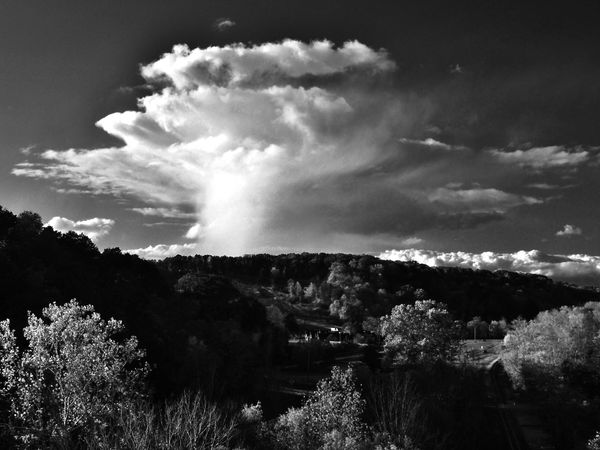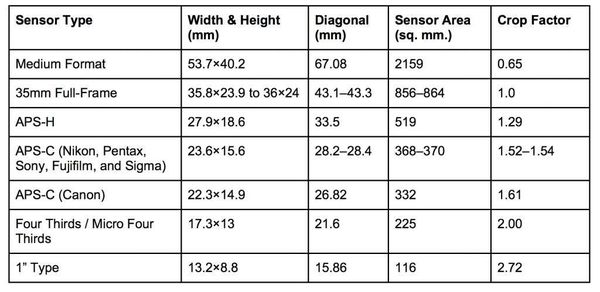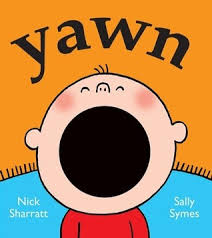Size matters
Nov 28, 2018 19:51:48 #
Smaller format:
Pros--
* Faster lenses (for a given angle of view, e.g.,, a "normal". lens)
Cons--
* More diffraction (for a given f/stop)
* Fewer usable f/stops
* Less maximum depth-of-field (e.g. for a "normal" lens)
* Smaller sensor/film area = less resolution possible
Larger format:
Pros--
* More "pixels"
* Less diffraction (for a given f/stop)
* Higher resolution (for both the above reasons)
* More usable f/stops (for a given angle-of-view lens, e.g, a "normal" lens)
* Hence, capable of greater depth-of-field
Cons--
* Slower lenses (for a given type, e.g., "normal".)
Choices available right now range from 1"x1" digital sensor to 8" x 10" film
(80 times more area). Tradtiionally, these are classified as:
Sub-minature format: below 36 mm x 24 mm
Minature format: 36 mm x 24 mm
Medium format: 120 film (several different frames)
Large format: 4" x 5" and above
You pay your money, you take your choice. There is no single "best" format--
it depends on subject, lighting, location, your style and how you intend to display
or print the image. But the limitations of any given format are real: format matters.
Unfortunately, medium format digital cameras start at about $4500 with DSLRs
starting at about $5000 (body only). That's unaffordable for most photographers.
And large format digital cameras (4" x 5" and larger) are not available--sensors
that big aren't made.
By contrast, a sheet of 8" x 10" film costs about $5 and can be used in home-made
box camera: expensive per shot, but not per camera.
That home-made box camera can shoot at f/64 on its "normal" lens (about 300 mm)
-- with enormous depth-of-field. But a brand new, top-of-the-line, "full-frame" camera
can't (the image would be hopelessly unsharp, so they don't even put f/32
on the focus ring--let alone f/64).
Digital vs. 135 film has good points on both sides. But digital vs. large format film has no
points on the digital side--because there are no large format digital cameras, except in observatory
telescopes.
Large format was the predominant form of photography for over 100 years. Now it is
almost extinct. We shouldn't fool ourselves by pretending this is not a loss. The drop
in quality in landscape photography since the 1970s is very noticable.
Pros--
* Faster lenses (for a given angle of view, e.g.,, a "normal". lens)
Cons--
* More diffraction (for a given f/stop)
* Fewer usable f/stops
* Less maximum depth-of-field (e.g. for a "normal" lens)
* Smaller sensor/film area = less resolution possible
Larger format:
Pros--
* More "pixels"
* Less diffraction (for a given f/stop)
* Higher resolution (for both the above reasons)
* More usable f/stops (for a given angle-of-view lens, e.g, a "normal" lens)
* Hence, capable of greater depth-of-field
Cons--
* Slower lenses (for a given type, e.g., "normal".)
Choices available right now range from 1"x1" digital sensor to 8" x 10" film
(80 times more area). Tradtiionally, these are classified as:
Sub-minature format: below 36 mm x 24 mm
Minature format: 36 mm x 24 mm
Medium format: 120 film (several different frames)
Large format: 4" x 5" and above
You pay your money, you take your choice. There is no single "best" format--
it depends on subject, lighting, location, your style and how you intend to display
or print the image. But the limitations of any given format are real: format matters.
Unfortunately, medium format digital cameras start at about $4500 with DSLRs
starting at about $5000 (body only). That's unaffordable for most photographers.
And large format digital cameras (4" x 5" and larger) are not available--sensors
that big aren't made.
By contrast, a sheet of 8" x 10" film costs about $5 and can be used in home-made
box camera: expensive per shot, but not per camera.
That home-made box camera can shoot at f/64 on its "normal" lens (about 300 mm)
-- with enormous depth-of-field. But a brand new, top-of-the-line, "full-frame" camera
can't (the image would be hopelessly unsharp, so they don't even put f/32
on the focus ring--let alone f/64).
Digital vs. 135 film has good points on both sides. But digital vs. large format film has no
points on the digital side--because there are no large format digital cameras, except in observatory
telescopes.
Large format was the predominant form of photography for over 100 years. Now it is
almost extinct. We shouldn't fool ourselves by pretending this is not a loss. The drop
in quality in landscape photography since the 1970s is very noticable.
Nov 28, 2018 20:05:22 #
Bipod wrote:
Smaller format: br Pros-- br * Faster lenses (for ... (show quote)
"Choices available right now range from 1"x1" digital sensor to 8" x 10" film"
Is there actually a camera sensor that measures 1" x 1"?
Nov 28, 2018 21:51:36 #
Bipod wrote:
We shouldn't fool ourselves by pretending this is not a loss. The drop
in quality in landscape photography since the 1970s is very noticable.
in quality in landscape photography since the 1970s is very noticable.
This is typical gear head bs.
https://www.markmetternich.com - show me another photographer with what ever gear you believe that takes better pictures than Mark.
If anything, the quality of today’s top photographers are better than what was produced in the past.
I know you don’t personally have anything to show, you never show any photos and we are on a photo forum.
I will not hold my breath, because you just troll.
Nov 28, 2018 23:03:50 #
Nov 29, 2018 01:49:34 #
tdekany wrote:
https://www.markmetternich.com - show me another photographer with what ever gear you believe that takes better pictures than Mark.
https://www.markmetternich.com - show me another photographer with what ever gear you believe that takes better pictures than Mark.
Surely you must be joking. Those are horrible examples of landscape photography. Everything drowned in candy colors. Nothing looks real. That's fantasy photography, not landscape photography.
Nov 29, 2018 01:51:27 #
rook2c4 wrote:
Surely you must be joking. Those are horrible examples of landscape photography. Everything drowned in candy colors. Nothing looks real. That's fantasy photography, not landscape photography.


Nov 29, 2018 06:02:28 #
tdekany wrote:
This is typical gear head bs.
https://www.markmetternich.com - show me another photographer with what ever gear you believe that takes better pictures than Mark.
If anything, the quality of today’s top photographers are better than what was produced in the past.
I know you don’t personally have anything to show, you never show any photos and we are on a photo forum.
I will not hold my breath, because you just troll.
https://www.markmetternich.com - show me another photographer with what ever gear you believe that takes better pictures than Mark.
If anything, the quality of today’s top photographers are better than what was produced in the past.
I know you don’t personally have anything to show, you never show any photos and we are on a photo forum.
I will not hold my breath, because you just troll.
I won’t be signing-up for any of Mark’s workshops any time soon. Yuck. Website images are antithesis of what *I* consider “state of the art” or desirable results. To each his/her own.
Nov 29, 2018 06:49:21 #
Jeffcs
Loc: Myrtle Beach South Carolina
Again the equipment is an expensive brick until it is put in the hands of an artist!
Bigger question is why am I even posting on this thread?
Bigger question is why am I even posting on this thread?
Nov 29, 2018 07:16:33 #
Bipod wrote:
Smaller format: br Pros-- br * Faster lenses (for ... (show quote)
Interesting thoughts.
I disagree with your theory for today's equipment.
AZ Highways has very high standards for what they publish.
And in the era of film 35mm was only considered for publishing if there was an absolute reason it was the only option to get the shot.
4X5 was the preferred minimum. David Muench was the primary photographer.
Today that has all changed with digital.
Nov 29, 2018 07:41:15 #
Bipod wrote:
Smaller format: br Pros-- br * Faster lenses (for ... (show quote)
"Pro" means a positive virtue, not a short list of your personally described short comings.
Duh, there is no question that a good big man will beat a good small man any day of the week, and so what. The talent of yesterday casts a long shadow on the work done by today's photographers, but alas it is but a shadow, we stand on the shoulders of giants true, but the cliche' machine needs a rest. You say nothing new, just curmudgeonly dictate your nostalgic regrets.
storm over Boston Mills

Nov 29, 2018 07:53:19 #
berchman
Loc: South Central PA
rook2c4 wrote:
Surely you must be joking. Those are horrible examples of landscape photography. Everything drowned in candy colors. Nothing looks real. That's fantasy photography, not landscape photography.
I don't like overcooked pictures, but call them what you will, these are spectacular photos. If you have special criteria for "landscape" photos, then maybe we should just call these "art" photos.
Nov 29, 2018 08:08:28 #
le boecere wrote:
Is there actually a camera sensor that measures 1" x 1"?
I wish they had used something understandable for sensor sizes. We all know the term "35mm," so why not stick with that and refer to a "28mm" or a "13mm" sensor?
Below is a chart with the actual measurements.

Nov 29, 2018 08:35:33 #
AlfredU
Loc: Mooresville, NC
le boecere wrote:
"Choices available right now range from 1"x1" digital sensor to 8" x 10" film"
Is there actually a camera sensor that measures 1" x 1"?
Is there actually a camera sensor that measures 1" x 1"?
No. There are bridge cameras that claim to use a 1 inch sensor, but the actual sensor only measures a little over a half inch. This is from an older format that counted the size of the frame and housing for the sensor which measured an inch. But the sensor doesn't come close. This fact was revealed to me on this forum a while back. I looked it up and it is true. Thank you UHH.
Nov 29, 2018 08:44:04 #
tdekany wrote:
This is typical gear head bs.
https://www.markmetternich.com - show me another photographer with what ever gear you believe that takes better pictures than Mark.
If anything, the quality of today’s top photographers are better than what was produced in the past.
I know you don’t personally have anything to show, you never show any photos and we are on a photo forum.
I will not hold my breath, because you just troll.
https://www.markmetternich.com - show me another photographer with what ever gear you believe that takes better pictures than Mark.
If anything, the quality of today’s top photographers are better than what was produced in the past.
I know you don’t personally have anything to show, you never show any photos and we are on a photo forum.
I will not hold my breath, because you just troll.
This is rude and out of order here, just name calling. The points made were very reasonable. (I’m not refereeing the absolute correctness of everything, but the post was at least mostly correct). Large formats such s 12” x 12” WILL have Superior resolution. That’s why the CIA, U2 aircraft, etc. used VERY large film in their surveillance operations. If size didn’t matter, we would all use tiny sensors.
Nov 29, 2018 09:03:39 #
AlfredU
Loc: Mooresville, NC
berchman wrote:
I don't like overcooked pictures, but call them what you will, these are spectacular photos. If you have special criteria for "landscape" photos, then maybe we should just call these "art" photos.
Wow, "horrible examples of landscape photography", "spectacular photos", "art photos"? It's interesting how subjective photography can be. But I don't understand the contradiction. If you don't like overcooked photos then how can they be spectacular? And although I don't prefer overcooked, too slick images like Mark's, I would be hard pressed to call them horrible. I would suggest that we try to at least be respectful of each other's opinions about what is good photography or not. And we kind of got off the topic of size matters. I thought the OP made an interesting and somewhat thought provoking comparison. Again, my opinion.
If you want to reply, then register here. Registration is free and your account is created instantly, so you can post right away.




